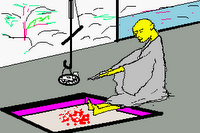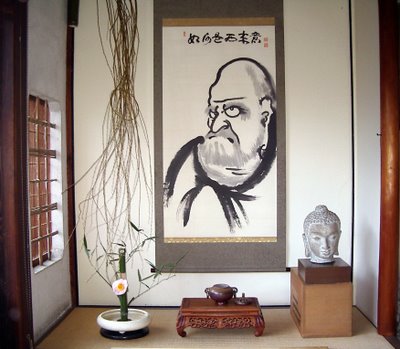:::::::::::::::::::::::::::::::::::::::::::::::::::::::::::::::::::::::::::::::::::::::::::::::::::::::::::::::::::::::::::::::::::::::::::::::::::::::::::::::::::::::::::::::::::::
irori 囲炉裏 / 居炉裏 / いろり open sunken hearth
It has many local names, for example
iroi イロイ / jiro ジロ / ijiro イジロ / yurui ユルイ / hidoko ヒドコ / hijiro ヒジロ
- part of the entry about
. Interior Design - The Japanese Home .
. daidokoro 台所 the Japanese kitchen .
- Introduction -

source : kodairanoyama.wordpress.com
.......................................................................
- quote
irori 囲炉裏 - also written 居炉裏.
Also called ro 炉. An open hearth set in the floor of various rooms in Japanese buildings. Believed by some to have referred originally to the periphery of the hearth, the term was generally used for the hearth itself. It provided heat, light and in many cases a place for cooking suiji 炊事.
For cooking purposes, pots or kettles were either placed upon tripods, or suspended from the beams above the heat using an adjustable hook *jizaikagi 自在鈎 which might be decorative.
Irori size varied from around 45x45cm (in teahouses) to 2mx1m, with 90x90cm being the average. The irori was usually square.
There were two main types. The simplest was a pit excavated directly in the surface of the ground, partially backfilled with sand and ash and edged with stones or timber. This kind of irori was common in the poorer vernacular houses *minka 民家, of the Edo period, which had a low floor of rice husks and reed matting *doza 土座 instead of a raised floor. This type resembles the hearths unearthed in excavations of prehistoric pit dwellings *tateana juukyo 竪穴住居.
The second type of irori was constructed into the raised timber floor, takayuka 高床, and edged with timber or occasionally stone. A mound of stones and earth brought up to the level of the underside of the floor formed the base. A hollow fire pit, usually lined with plaster *shikkui 漆喰, was then made in the center of this base.
The irori was already in use in the upper class residences of the Heian period, where it was termed *jihiro 地火炉. It was also found in shoin style residences *shoin-zukuri 書院造, especially in service rooms such as the kitchens *daidokoro 台所, *kiyodokoro 清所, and in style rooms *sukiya 数寄屋, and tea houses *chashitsu 茶室. In minka it was found not only in the kitchen, but also in the center of the main living room *hiroma 広間, *oue 御上 (o-ue), where it was a focus of everyday life around which meals were eaten and informal visitors entertained.
The sitting arrangement around the irori in minka was fixed: the seat at the upper end *kamite 上手, overlooked the earthfloored area *doma 土間, called the *yokoza 横座, was for the master of the house. The seat opposite him, called variously *kijiri 木尻, hijiri 火尻, or *shimoza 下座, was the lowest in rank and was used by junior family members, dependents and servants, or for fuel storage. The seat toward the rear of the house, closest to the kitchen area, was the wife's seat *nyoubouza 女房座 (nyoobooza), ubaza うば座, kakaza かか座, tanamoto 棚もと. The seat opposite her (nearest to the entry in *hirairi 平入 houses) was used by visitors or by the eldest son and was called *kyakuza 客座, mukouza 向座, or otokoza 男座.
All of these seats have a wide variety of local names. The irori was a feature of minka in almost all parts of the country, and in Touhoku 東北 region, it was quite common for houses to have two. An exception was the Kinki 近畿 region around Nara, Kyoto and Osaka, where, from the mid-Edo period, the irori virtually ceased to be used in the vicinity of major urban areas. Irori has a wide range of regional names and pronunciation variants, of which the main ones are yururi ゆるり, yurui ゆるい, irui いるい, yuri ゆり, iri いり, ennaka えんなか, hinata ひなた, hitakijiro 火焚き地炉, hijiro 火地炉.
- source : JAANUS

CLICK for more photos !
. sukiya 数寄屋 tea ceremony room .
..............................................................................................................................................
jizaikagi 自在鉤 pot hook, Kesselhaken
to hang a pot above the open fire of a hearth (irori 囲炉裏).
 f
ffrom my collection
- quote
jizaikagi 自在鈎 pothook.
A device that enables a pot nabe 鍋 or tea kettle tetsubin 鉄瓶 to be suspended over a sunken hearth * irori 囲炉裏. It was called jizaikagi (free hook) because the pothook was adjustable, allowing a pot to be lowered or raised away from the fire as required. The most basic type consisted of a piece of rope from which the pot was suspended, tied to one end of a freely suspended wooden or metal element called *saru 猿.
The loose end was passed over a beam, and then threaded through a hole in the other end of the saru, and knotted to the hook kagi 鈎 which supported the pot. The drag tension on the rope as it passed through the saru kept the pot at the desired height; the height could be adjusted and the tension could be relaxed by changing the angle of the saru. The saru became a readily recognizable part of domestic architecture as it was often decoratively designed in the form of a fan or a fish, or the mallet of the god *Daikokuten 大黒天, which was believed to bring prosperity.
More sophisticated jizaikagi used two bamboo or metal poles takesao 竹棹 but they also relied upon the principal of drag tension and the use of the saru. It is not known when the jizaikagi was invented but it was already in use in the Muromachi period. It was used in service buildings, vernacular houses *minka 民家 and tea houses *chashitsu 茶室. It is said to have been introduced into tea houses by Takeno Jouou 武野紹鴎 (1502-55), inspired by one he had seen in a rural house.
Often abbreviated to jizai 自在, it also had a variety of local names including kagidoko 鈎どこ, Nagano prefecture; tsurikagi 吊り鈎, Ishikawa prefecture; kagizuru 鈎づる, Gifu prefecture; and oansama おあん様, Chiba prefecture.
- source : JAANUS

source : facebook
with Fuji San"-shaped saru counterweight
:::::::::::::::::::::::::::::::::::::::::::::::::::::::::::::::::::::::::::::::::::::::::::::::::::::::::::::::::::::::::::::::::::::::::::::::::::::::::::::::::::::::::::::::::::::
- - - - - H A I K U and S E N R Y U - - - - -
open Japanese hearth, irori 囲炉裏
Click for more photos!
ro 炉 hearth
irori 囲炉裏 sunken hearth
robi 炉火 fire in the hearth
danboo 暖房 / 煖房 fireplace
ro akari 炉明 light from the hearth
. WKD - ro 炉 hearth .
- - kigo for all winter
..... uzumibi 埋火, うずみび

Ryokan warming himself at a small fire (uzumibi) 埋火(うずみび)
..............................................................................................................................................
五つ六つ茶の子にならぶ囲炉裏哉
itsutsu mutsu cha no ko ni narabu irori kana
Irori and tea cakes with
. Matsuo Basho 松尾芭蕉 - Archives of the WKD .
:::::::::::::::::::::::::::::::::::::::::::::::::::::::::::::::::::::::::::::::::::::::::::::::::::::::::::::::::::::::::::::::::::::::::::::::::::::::::::::::::::::::::::::::::::::

source : dream326.blog.fc2.com
仏師逝き火なき囲炉裏を残したる
busshi naki hi naki irori o nokoshitaru
the Buddhist sculptor is dead
and left the sunken hearth
without a fire . . .
Makino Shunku 牧野春駒
. Buddhist Sculptors Gallery .
..............................................................................................................................................

自在鉤に荒彫りの鯉ビール酌む
jizaikagi ni arabori no koi biiru kumu
as a pot hook
a roughly carved carp -
pouring beer
Ishikawa Keiroo 石川桂郎 Ishikawa Keiro (1909 - 1975)
. biiru ビール .. 麦酒 beer, Japanisches Bier .
- - kigo for all Summer - -
..............................................................................................................................................

source : www7b.biglobe.ne.jp/~studio-takao
Yasome Aiko 八染藍子
炉開きや鯉まろまろと自在鉤
robiraki ya koi marumaru to jizaikagi
opening the hearth -
a well-rounded carp
as our pot hook
Yasome Aiko 八染藍子 (1934 - )
. Robiraki 炉開き"Opening the hearth" .
irori hiraki 囲炉裏開く(いろりひらく)"opening the open hearth"
- - kigo for November - Tea Ceremony - -

CLICK for more photos !

- - - - - how to install the pot hook carp
- source : store.shopping.yahoo.co.j
:::::::::::::::::::::::::::::::::::::::::::::::::::::::::::::::::::::::::::::::::::::::::::::::::::::::::::::::::::::::::::::::::::::::::::::::::::::::::::::::::::::::::::::::::::::

- - - To join me on facebook, click the image !
:::::::::::::::::::::::::::::::::::::::::::::::::::::::::::::::::::::::::::::::::::::::::::::::::::::::::::::::::::::::::::::::::::::::::::::::::::::::::::::::::::::::::::::::::::::
. Japanese Architecture - Interior Design - The Japanese Home - Introduction .

. My collection in facebook .
[ . BACK to DARUMA MUSEUM TOP . ]
[ . BACK to WORLDKIGO . TOP . ]
:::::::::::::::::::::::::::::::::::::::::::::::::::::::::::::::::::::::::::::::::::::::::::::::::::::::::::::::::::::::::::::::::::::::::::::::::::::::::::::::::::::::::::::::::::::
































